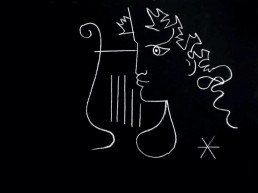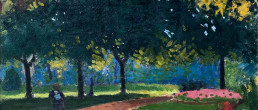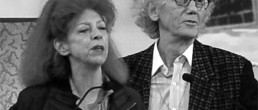Jean Cocteau
1889 (Maisons-Laffitte) - 1963 (Milly-la-Forêt)

Biography
Jean Cocteau was born in Maisons-Laffitte in 1889.
Born in a comfortable middle-class family, he studied at the Lycée Condorcet in Paris. He is 9 when his father commits suicide.
At the same time artist and dandy, he publiches his firts poems in 1909 and become an important trendy personality of the great intellectual Paris of the “salons“, these meetings where once could have met the Daudet, la Comtesse de Noailles, or Marcel Proust. In 1913, the creation by Diaghilev of the ballet Le Sacre du Printemps (by Stravinsky) has deeply influenced Jean Cocteau.
Ambulance driver during the First World War, he met there Guillaume Apollinaire and they became friends.
The inter-war period has been full of creativity and great collaborations for Jean Cocteau, now considered as a very famous poet, writer, draftsman in Paris : he collaborated at this time with Erik Satie (Parade, 1917), or Darius Milhaud, and with several painters from the Avant-Garde.
Inspired in his writing work by futurism, dadaism, cubism, – he was a close friend of Pablo Picasso – he found his inspiration in all the cultural movements of the period : : Le Cap de Bonne Espérance (1919), is inspired by cubism, whereas Le Potomac (1919), Thomas l’imposteur (1923), or Les Enfants terribles (1929) are more romantic.
He is not just a great novelist, but also a great theatre writer and director : Les Mariés de la tour Eiffel (1924), La Voix humaine (1930), La Machine infernale (1934), Les Parents terribles (1938), Les Monstres sacrés (1940), La Machine à écrire (1941), L’Aigle à deux têtes (1946), Bacchus (1952).
Jean Cocteau has also been a great film-maker. His scenarios are famous too, as Le Sang d’un poète (1930), L’Éternel retour (1943), La Belle et la Bête (1945), Les Parents terribles (1949), Orphée (1950), and the last film he made, Le Testament d’Orphée (1960), for years before his death.
But as said, Jean Cocteau is a complete artist : he draws, he paints too. Very talented draftsman, he has also decorated two chapels : in Villefranche-sur-mer and in Milly-la-Forêt.
In Menton, in the south of France where he loved to spent his time, a Jean Cocteau Museum has opened its door a few years ago.
Talented master in every Art category, its Work is polymorpheous, inspired by all the Avant-Garde movements, but also by classical mythology, and poetry : Astonishment is the only common notion of all the works he produced – astonishment of Cocteau himself toward Life, but also astonishment of the spectator of his creations.
Jean Cocteau was elected to l’Académie française on the 3rd march of 1955, as one of the greatest writers of the country.
He died in 1963.







